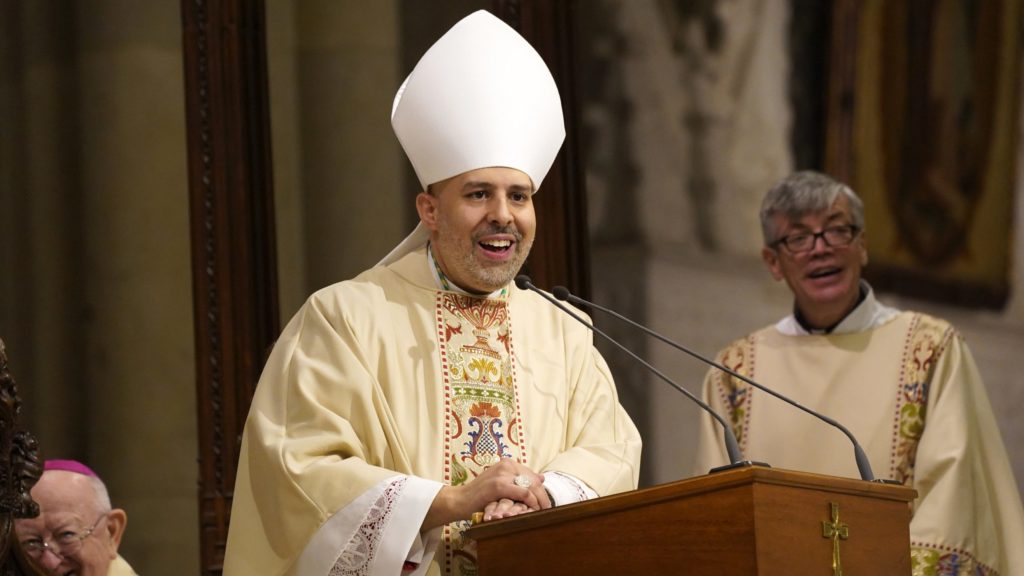At the age of 25, Joseph Espaillat was ordained a priest. Now, at the age of 45, he serves as an auxiliary bishop in the Archdiocese of New York, making him America’s youngest Catholic bishop.
He currently serves as the pastor at St. Anthony of Padua Roman Catholic Church in the Bronx as well as the director of the Hispanic Catholic Charismatic Renewal for the archdiocese and at the Hispanic Catholic Charismatic Center in the Bronx.
In an interview with Montse Alvarado on “EWTN News In Depth,” the bishop admitted that previously he “was not charismatic at all.”
“I was the St. Paul, or rather Saul, because I was like ‘These charis-maniacs! What’s up with that?’”
He shared that when Cardinal Timothy Dolan came to the Archdiocese of New York, he named Espaillat the director of youth ministry. However, after several years working in the ministry, Dolan had new plans for the young bishop.
Espaillat recalled: “All of a sudden it was like, ‘Hey, I want you to go to St. Anthony of Padua Church. Have you heard of it?’”
“I’m like, ‘El Centro?’ And he’s like, ‘Yeah.’ And I’m like, ‘With the charismatics?’ And I’m like, ‘Oh no, you got the wrong guy!’ And then he says to me, ‘No, I got the right guy.’ ”
After receiving the news, Espaillat decided to go on a retreat at Franciscan University of Steubenville, not realizing that they, too, were charismatic. It was there that he was “baptized in the Spirit.”
He said that his time at the Hispanic Charismatic Center has been “beautiful and edifying.”
“These last eight years have been just wonderful here because it’s changed the trajectory of my spirituality … and I’ve grown exponentially,” he added.
Hispanic ministry, language, and idioms
For several decades, Latino Catholics have been a steadily growing segment of the Catholic Church in the United States. Earlier this year, the United States bishops released their new National Pastoral Plan for Hispanic Ministry, with evangelization and mission topping the pastoral priorities for the country’s growing population of 30 million Latino Catholics.
Espaillat believes that in order to reach this demographic, as well as the youth, “we have to speak the language of the people.”
“Let’s follow the example of Jesus. Jesus spoke in the language of the people and he used the images that they knew and he used the analogies that they would understand,” he explained.
“Are we speaking the language of the people?” he asked. “And I’m not just referring to English. Spanish. I’m talking about the idioms as well.”
Espaillat shared that when he is introduced, people say he speaks three languages — English, Spanish, and street.
He explained that in order to evangelize, one must be willing to understand the culture.
“I know what the young kids are saying out there … You got to understand the culture if you want to understand the young people.”
Meet people where they’re at
He added: “Not that you have to agree with it. Not that you’re going to be rocking to their music or whatever it is, but at least it’s a starting block. Meet them where they’re at.”
Throughout his time working with the youth, Espaillat has seen that “they are hungering” for the faith but the Church has “been fearful” of ministering to them.
“They want to hear the truth,” he said. “They want more. So we have to do a better job as Church and not be afraid, not be afraid, of approaching them and ministering to them and being with them and accompanying them because that’s what they want.”
Espaillat gave one example on how he talks to the youth about Mass being a celebration and the importance of the Eucharist. He gave the analogy of going to a party and not eating or seeing your mother cooking all day in the kitchen and then telling her you are not going to eat.
“How do you think God the Father feels when he offers us his Son, when he offers us the body, blood, soul, and divinity of Jesus, and we reject him?”
“When you speak in that manner to young people, it clicks. They get it,” he added. “They want to hear more. They want to be engaged. And as Church we need to do a better job helping young people come back to the feet of Jesus.”
“Since being named bishop, I’ve had a lot of young people just say, ‘Hey, you know what? I can relate to you. I can see myself in you.’ And that’s a positive. That’s a great sign because then they know, ‘Hey there’s more, or there can be more,’ and that’s what we’re called to do, right?”

